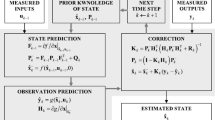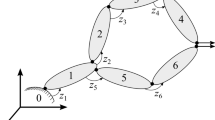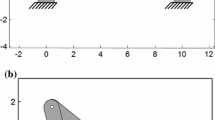Abstract
In the multibody field the design of state observers proves useful for several tasks, ranging from the synthesis of control schemes and fault detection strategies, to the identification of uncertain parameters. State observers are designed to obtain accurate estimates of unmeasurable or unmeasured variables. Their accuracy and performance depend on both the models used and the measurement sets. In multibody systems, if it is reasonable to neglect joint clearance and to assume that links are rigid, the estimates of kinematic variables (i.e. position, velocity and acceleration) can be carried out very effectively using kinematic models, i.e. models based on kinematic constraint nonlinear equations, which provide much less uncertain models than dynamic equations. Under the aforementioned assumptions, this paper proposes a general theory, valid for both open-chain and closed-chain multibody systems, to design observers based on nonlinear kinematic models. The concurrent use of kinematic models and nonlinear estimators is original in the multibody field and represents the chief contribution of the paper. The soundness of the proposed theory is proved through numerical and experimental tests on both open-chain and closed-chain multibody systems. Finally, a comparison is given between the kinematic estimations computed through two nonlinear observers (the extended Kalman filter, EKF, and the spherical simplex unscented Kalman filter, SS-UKF), in order to demonstrate the benefits of the SS-UKF in nonlinear estimation.











Similar content being viewed by others
References
Caracciolo, R., Richiedei, D., Trevisani, A.: Robust piecewise-linear state observers for flexible link mechanisms. J. Dyn. Syst. Geom. Theories 130, 031011 (2008)
Kalman, R.E.: A new approach to linear filtering and prediction problems. J. Basic Eng. 82, 35–45 (1960)
Cuadrado, J., Dopico, D., Perez, J.A., Pastorino, R.: Automotive observers based on multibody models and the extended Kalman filter. Multibody Syst. Dyn. 27(1), 3–19 (2012)
Pastorino, R., Richiedei, D., Cuadrado, J., Trevisani, A.: State estimation using multibody models and non-linear Kalman filters. Int. J. Non-Linear Mech. 53, 83–90 (2013)
Jeon, S., Katou, T., Tomizuka, M.: Kinematic Kalman Filter (KKF) for robot end-effector sensing. J. Dyn. Syst. Geom. Theories 131(2), 021010 (2009)
Jeon, S.: State estimation based on kinematic models considering characteristics of sensors. In: Proceedings American Control Conference, Baltimore, pp. 640–645 (2010)
Wang, C., Chen, W., Tomizuka, M.: Robot end-effector sensing with position sensitive detector and inertial sensors. In: Proceedings IEEE International Conference on Robotics and Automation, pp. 5252–5257 (2012)
Žumer, J., Slavič, J., Boltežar, M.: Minimization of the positional errors for an accurate determination of the kinematic parameters of a rigid-body system with miniature inertial sensors. Mech. Mach. Theory 81(0), 193–208 (2014)
Haug, A.J.: Bayesian Estimation and Tracking: A Practical Guide. Wiley, New York (2012)
Van Der Merwe, R., Wan, E.A., Julier, S.: Sigma-point Kalman filters for nonlinear estimation and sensor-fusion: applications to integrated navigation. In: Proceedings of the AIAA Guidance, Navigation & Control Conference, pp. 16–19 (2004)
Julier, S.: The spherical simplex unscented transformation. Proc. Am. Control Conf. 3, 2430–2434 (2003)
Julier, S.: The scaled unscented transformation. Proc. Am. Control Conf. 6, 4555–4559 (2002)
Julier, S., Uhlmann, J.K.: Reduced sigma point filters for the propagation of means and covariances through nonlinear transformations. Proc. Am. Control Conf. 2, 887–892 (2002)
De Jalón, J.G., Bayo, E.: Kinematic and Dynamic Simulation of Multibody Systems. Springer, New York (1994)
Grewal, M.S., Andrews, A.P.: Kalman Filtering: Theory and Practice Using MATLAB. Wiley, New York (2011)
Hermann, R., Krener, A.J.: Nonlinear controllability and observability. IEEE Trans. Autom. Control 22(5), 728–740 (1977)
Reif, K., Günther, S., Yaz, E., Unbehauen, R.: Stochastic stability of the discrete-time extended Kalman filter. IEEE Trans. Autom. Control 44(4), 714–728 (1999)
Richiedei, D., Trevisani, A.: Vibration confinement in lightly damped multibody systems: an hybrid active–passive approach. In: Proceedings ECCOMAS Thematic Conference on Multibody Dynamics, Zagreb, Croatia (2013)
Lanczos, C.: Applied Analysis. Courier Dover, New York (1988)
Author information
Authors and Affiliations
Corresponding author
Rights and permissions
About this article
Cite this article
Palomba, I., Richiedei, D. & Trevisani, A. Kinematic state estimation for rigid-link multibody systems by means of nonlinear constraint equations. Multibody Syst Dyn 40, 1–22 (2017). https://doi.org/10.1007/s11044-016-9515-x
Received:
Accepted:
Published:
Issue Date:
DOI: https://doi.org/10.1007/s11044-016-9515-x




